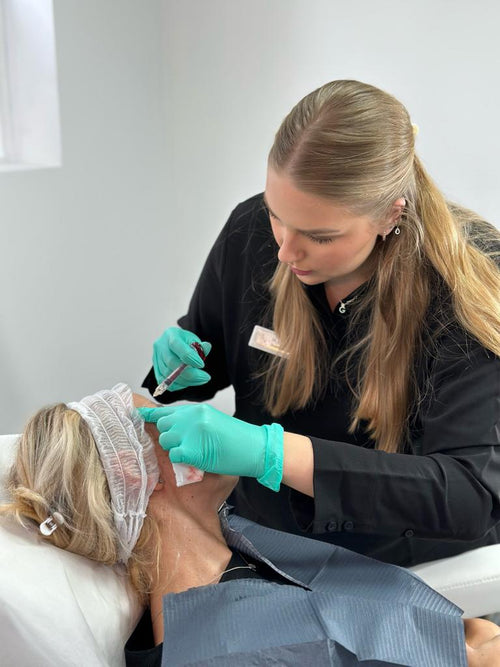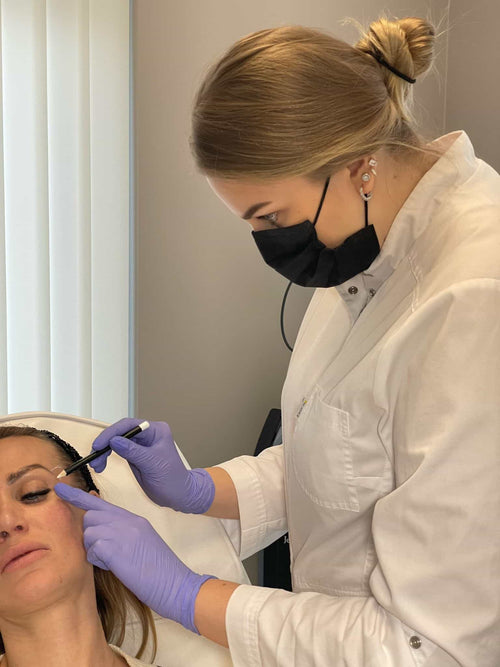Arrange a Dermal Filler Session with Dr. Laura Geige Now

Factors Influencing Treatment Frequency

Genetics
Several factors influence how often you’ll need tear trough filler injections.
Here are some key considerations:
-
Volume of Filler Used Initially
-
Type of Filler
-
Individual Metabolism and Skin Elasticity
-
Sun Exposure
-
Lifestyle Habits
-
Facial Expressions and Movement
A larger volume of filler will generally last longer than a smaller volume.
Different fillers have varying lifespans. Hyaluronic acid fillers, for example, tend to last 6-18 months, while some other types may be more long-lasting.
Everyone’s body processes substances differently. Some people naturally break down filler faster than others. Similarly, those with firmer, more elastic skin may find that their results last longer.
Excessive sun exposure can accelerate the breakdown of collagen and hyaluronic acid, potentially shortening the lifespan of tear trough filler.
Smoking, excessive alcohol consumption, and dehydration can all contribute to premature aging and affect the longevity of filler results.
Frequent squinting, frowning, or smiling can put stress on the treated area, potentially causing the filler to dissipate more quickly.
Genetics can also play a role in how long tear trough filler lasts. Some individuals are genetically predisposed to faster collagen breakdown, which may lead to shorter-lasting results, regardless of other factors. It’s important to have realistic expectations about the longevity of any cosmetic treatment and discuss these factors with your physician.
Lifestyle Factors
Several factors influence how often you might need tear trough filler injections to maintain desired results.
Treatment Frequency Based on Individual Factors
Age: Younger individuals tend to metabolize fillers faster, requiring more frequent touch-ups.
Skin Type and Elasticity: Thinner, more delicate skin may require more frequent treatments than thicker, more resilient skin.
Facial Structure & Anatomy: The depth and prominence of the tear trough naturally vary from person to person, influencing the amount of filler needed and its longevity.
Lifestyle Factors Impacting Treatment Duration
Sun Exposure: UV radiation breaks down collagen and hyaluronic acid (the primary ingredient in most fillers), potentially leading to faster degradation. Consistent sun protection can help prolong treatment results.
Book a Dermal Filler Consultation at It’s Me and You Clinic with Dr. Laura Geige
Smoking: Nicotine constricts blood vessels, hindering circulation and reducing the skin’s ability to heal and retain filler. Smokers often experience shorter-lasting filler effects.
Facial Expressions: Frequent use of facial muscles during expressions like smiling or frowning can contribute to faster breakdown of filler.
Product Choice & Technique Matters**
Filler Type and Concentration: Different fillers are formulated with varying degrees of cross-linking, which affects their longevity. Higher concentrations often last longer.
Injection Technique: A skilled injector can strategically place filler to maximize its volume and duration.
It’s crucial to consult with a board-certified dermatologist or plastic surgeon experienced in facial fillers. They can assess your individual needs, skin type, and lifestyle factors to determine the optimal frequency of tear trough treatments.
Individual Skin Type
Determining the ideal frequency for tear trough filler injections is a multifaceted process influenced by several factors, with individual skin type playing a prominent role.
Individual Skin Type:**
Skin thickness and elasticity significantly impact filler longevity.
– **Thin Skin:** Individuals with thin skin tend to see results from tear trough fillers last for a shorter duration, often requiring touch-up injections every 6 to 9 months.
– **Thick Skin:** Those with thicker skin may experience longer-lasting results, with touch-ups potentially needed every 12 to 18 months or even longer.
Beyond thickness, collagen production and overall skin health also play a role. Younger individuals with robust collagen production may retain filler longer than those with aging or compromised skin.
Other Contributing Factors:**
Alongside skin type, several other factors influence treatment frequency:
-
Filler Type:** Different dermal fillers have varying formulations and lifespans. Hyaluronic acid-based fillers, common for tear troughs, typically last 6 to 18 months.
-
Lifestyle:** Sun exposure, smoking, and dehydration can accelerate skin aging and potentially shorten filler results.
-
Facial Expressions:
Frequent frowning or squinting may cause fillers to break down faster around the tear trough area.
-
**Injection Technique:** The skill and experience of the injector influence how evenly the filler is distributed, affecting longevity.
It’s essential to consult with a qualified and experienced injector who can assess your individual skin type, concerns, and lifestyle factors to determine the most suitable treatment frequency for you. They can provide personalized recommendations and adjust the injection plan accordingly over time.
Average Treatment Duration
Expected Results
Average Treatment Duration for Tear Trough Fillers
Tear trough filler treatment typically takes around 15-30 minutes.
The procedure itself involves injecting hyaluronic acid dermal filler under the skin of the lower eyelid to volumize and smooth out the tear troughs.
Expected Results**
After tear trough filler treatment, you can expect:
*
Immediately noticeable reduction in the appearance of hollows and dark circles.
*
A more refreshed and youthful look.
*
Improved definition of the under-eye area.
*
Softening of wrinkles and fine lines around the eyes.
Duration of Results**
The results of tear trough filler are not permanent. Hyaluronic acid fillers naturally break down over time.
On average, you can expect the results to last between 6 months to a year.
Several factors can influence the longevity of your results, including:
*
The type of filler used
*
Your individual metabolism
*
Lifestyle factors such as sun exposure and smoking
It’s important to consult with a qualified and experienced injector to determine the best course of treatment for you and to manage your expectations.
Touch-Up Appointments
Average Treatment Duration for tear trough filler refers to the length of time the results of the treatment are typically visible.
This can vary significantly depending on several factors, including:
* Filler type:** Different hyaluronic acid fillers have varying viscosities and longevity. Some may last six months, while others can provide results for up to a year or more.
* **Individual metabolism:** Each person’s body metabolizes substances at a different rate. This can influence how quickly the filler is broken down.
* Lifestyle factors:** Sun exposure, smoking, and certain medications can affect the longevity of filler results.
* Treatment area:** Tear troughs are delicate areas with thinner skin, which may lead to faster breakdown of the filler.
While averages provide a general guideline, it’s important to consult with a qualified injector for personalized advice regarding treatment duration and touch-up schedules.
Touch-up appointments are essential to maintain the desired results after tear trough filler treatment. They involve injecting additional filler to restore volume and smoothness as the initial product gradually dissolves.
Here’s a breakdown of typical touch-up appointment frequency:
- Initial touch-up: Around 6 months after the initial treatment.
- Subsequent touch-ups: Depending on individual factors and filler longevity, touch-ups may be needed every 6 to 12 months.
Arrange a Dermal Filler Session with Dr. Laura Geige Now
During a touch-up appointment, the injector will assess the treated area, determine if any additional filler is required, and make necessary adjustments.
Maintaining Optimal Results
Post-Treatment Care
Maintaining optimal results post-treatment for tear trough filler involves several key factors. While individual results and longevity vary, following these guidelines can help maximize your results and minimize complications.
Here’s a breakdown of essential post-treatment care steps:
- Avoid Direct Pressure:
- Ice Application (Optional):
- Elevate Your Head:
- Minimize Sun Exposure:**
- Hydrate:
- Avoid Alcohol:**
- Resume Normal Activities Gradually:
- Follow Your Practitioner’s Instructions Carefully:**
Refrain from touching, rubbing, or pressing on the treated area for at least 24 hours after the procedure. This helps prevent bruising and ensures the filler settles properly.
Applying ice packs wrapped in a towel for 10-15 minutes at a time, several times a day, can help reduce swelling and discomfort in the initial hours after treatment.
Sleeping with your head slightly elevated can also minimize swelling by promoting lymphatic drainage.
UV rays can accelerate the breakdown of hyaluronic acid fillers. Wear sunglasses and sunscreen (SPF 30 or higher) to protect the treated area.
Drinking plenty of water helps keep your skin hydrated and promotes overall healing.
Alcohol can thin the blood and increase the risk of bruising.
You can typically return to most normal activities within a day or two, but avoid strenuous exercise or activities that involve heavy sweating for at least 24-48 hours.
Your provider will give you specific instructions based on your individual needs and the type of filler used. It is crucial to follow these guidelines diligently.
Remember, everyone heals differently. If you experience any unusual symptoms or concerns after tear trough filler treatment, contact your practitioner immediately.
Sun Protection
Maintaining optimal results from tear trough filler and ensuring sun protection are crucial for longevity and preventing complications.
Here’s a breakdown:
Maintaining Optimal Results
- Regular Touch-Ups: Tear trough filler gradually dissolves over time, typically lasting 6 to 18 months. Schedule touch-up appointments with your injector every 6-12 months to maintain the desired results.
- Lifestyle Factors: Smoking, excessive sun exposure, and dehydration can accelerate the breakdown of filler. Minimizing these factors can prolong its effects.
- Facial Expressions: While tear trough filler diminishes the appearance of under-eye hollows, it doesn’t prevent natural facial expressions. Over time, repetitive movements may slightly affect the filler placement.
Sun Protection
The delicate skin under the eyes is particularly vulnerable to sun damage. Following these sun protection practices is essential for preserving your results and protecting your skin’s health:
- Daily Sunscreen: Apply a broad-spectrum sunscreen with an SPF of 30 or higher every day, even on cloudy days.
- Reapplication: Reapply sunscreen every two hours, especially after swimming or sweating.
- Protective Clothing: Wear wide-brimmed hats and sunglasses to shield the under-eye area from direct sunlight.
Otherwheres Magazine Emily Patricia Fae Emri Studio C4YL Reimagining Journalism
- Traptox Aka Trapezius Botox Treatment Near Walton On The Hill, Surrey - May 25, 2025
- Nasal Flare Reduction Near Dunsfold, Surrey - May 24, 2025
- The Benefits Of CBD Gummies For Stress Management - May 24, 2025
